Jet Ski, WaveRunners, or Sea-Doo are the most popular personal watercraft (PWC) types of watersport businesses rent to the customers. To ensure that they last for years and you do not run into situations where you would not know why they won’t start, things like proper winter storage and de-winterization are a must. You need to look carefully after the battery to ensure your jet ski works properly. Here is the ultimate guide for you to refer to when you face any issue with your jet ski battery.
Choosing the Right Battery for YOU
First and foremost, choose the battery according to how you will exploit your PWC (e.g., year-round or high season only). In our case, we discuss it from tour operators’ perspective who are likely to utilize jet ski rather frequently. The jet ski rental business’s nature is that your equipment is being used almost non-stop by your customers during high seasons. Essentially, winter break is pretty much the only time you can fully commit yourself to your products’ maintenance. However, some jet ski rental businesses run their operations throughout the year. That is why it is even more crucial to make sure your WaveRunner’s “heart” functions in the right way. Considering the statements above, down below are the key factors we recommend paying attention to when choosing the battery for your WaveRunner based on individual abilities:
1) Weight/Size/Shape
Some are lighter than others and the other way around, so are the sizes and shapes. If you take your jet skis outside for the whole day and you provide your operations close to where you store them, then the weight would not, perhaps, be an ultimate deciding factor. However, if you deliver the equipment to the areas where it was requested, it may make sense to account for the compact and lighter models. By the way, if you are still on the lookout for a perfect location for your watersport business operations, make sure to listen to our podcast episode discussing arguments around that topic.
2) Compatibility with different PWC’s and other equipment types
Do you own just the Yamaha brand, and you do not have any Seadoo, or do you offer any additional equipment to rent, such as a snowmobile, ATV, or motorcycle? Some batteries can be compatible with different equipment types, not just the ones meant for watersport, so long as it fits. If that is your case, it might make sense to get something like this Odyssey Battery model because it is compatible with Yamaha EX, which is good for rentals.
3) Your availability for routine maintenance
If winter break is the only time you take to check on your jet ski or any other equipment conditions, then you can further narrow down your battery options. Some batteries, like this Pirate Battey model, are maintenance-free. Some are still not, like that same Odyssey Battery model mentioned earlier, so make sure to include this factor in your decision process.
4) Output voltage
As an add-on to the previous point, your maintenance availability will determine how often you can check on the battery’s voltage with a voltmeter. Ideally, you need to do it weekly. This will help make sure you avoid a complete battery drain, but if that is something you cannot check on regularly, then look for batteries like this Chrome Battery model. Their output balance is more balanced and easier to maintain.
5) Your budget
Some batteries are more expensive than others, but it does not mean that you should consider cheaper alternatives as worse ones. For example, Caltric AGM Battery’s low price can be a good option for tour operators renting Seadoo models this battery is compatible with. On the other hand, batteries like Odyssey can seem pricey, but that is partly because they can last longer than a season. Sometimes you may find yourself purchasing a used battery, which can be an option too, if you are deciding between getting new and used equipment that comes with it, for instance. Just remember that if you choose to go with a new battery, it should only cost you $50-$250 in 2021. Anything cheaper likely to have low quality, and anything more expensive is probably just overpriced.
What Characteristics Make Batteries Best
You will find many useful guides on the web to help you find the best battery that will fit your needs, like this one. As a rule of thumb, we recommend looking into the following characteristics to ensure your battery is as durable as it could be:
- AGM (Absorbed Glass Mat) Technology or Sealed Batteries. Avoid regular lead-acid batteries to ensure you spend on maintaining your battery as little as possible. Caltric AGM can be a good option, especially considering its low price.
- CCA (Cold Cranking Amps). Don’t let companies trick you; anything above 100 CCA would be just fine. As a rule of thumb, 100-350 CCA is more than enough; no extra selling points are getting added when someone says, “the more, the better.”
- Ability to withstand all of the knockings and bumpings. You will sometimes notice difficult customers out there who would not want to pay for the damaged equipment upon the rental completion. Considering how not cacareful they might be with the jet ski, this characteristic of the battery is useful to look for.
Where is the Battery in Jet Ski and How to Replace it
As obvious as it may seem, different PWC’s will have different spots in the equipment where the battery should be placed. Even one Yamaha WaveRunner model may vary to the other, not to mention Sea-Doo and Kawasaki Jet Ski. Either way, with Yamaha taking up to 90% of the rental market, arguably, here is the video for the vx1100 battery location and its replacement:
Notice the following are the most common tools you’ll need for changing a jet ski battery:
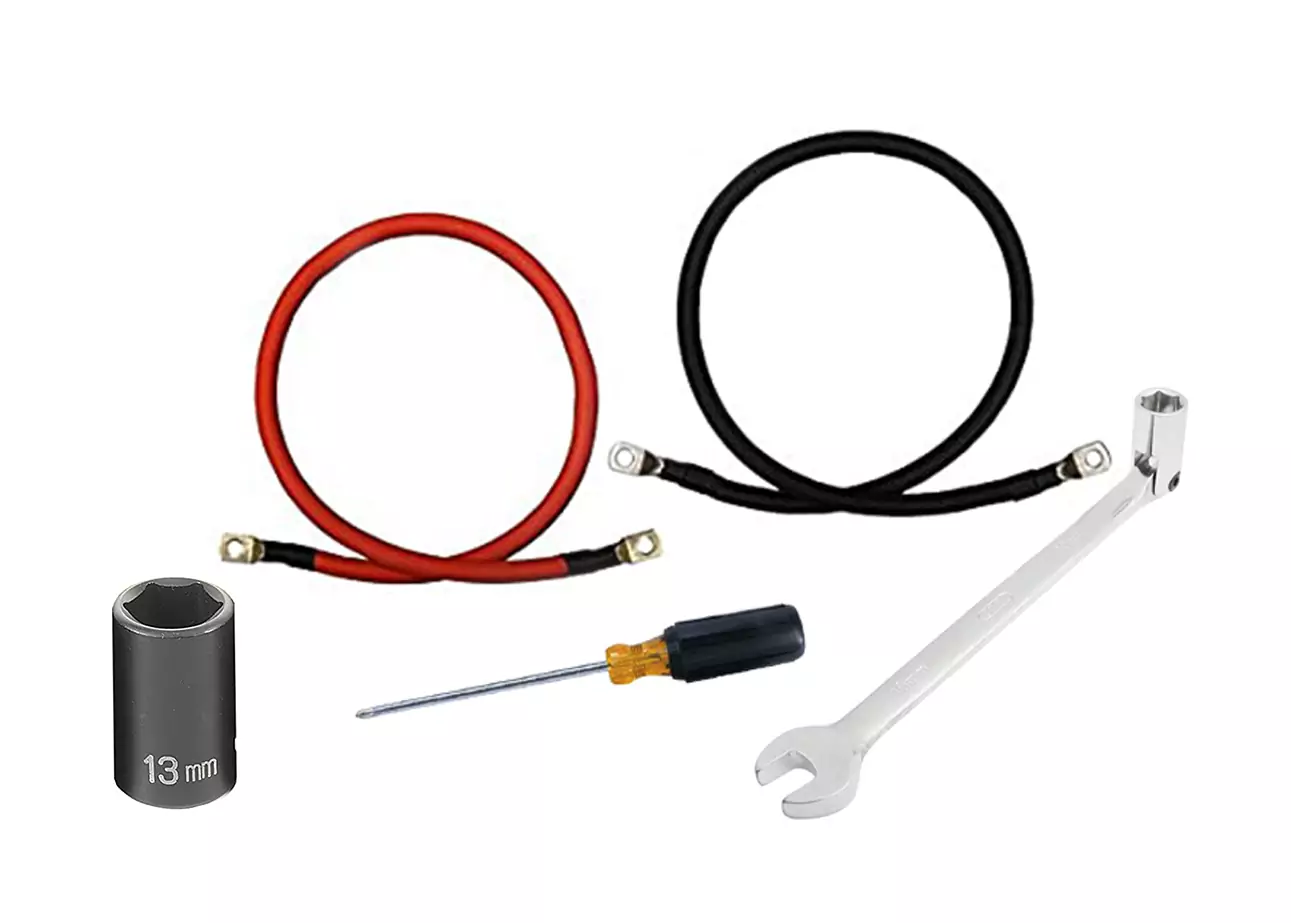
How to Extend Your Jet Ski Battery Lifetime: Things to Pay Attention to,
Common Issues & How to Fix Them
Now that you either replaced your old battery or found out that you can still use it, follow these guidelines to ensure that your battery functions longer than a single season.
Why is It Dying
First and foremost, before trying to fix your jet ski battery, it is good to understand what you are doing wrong with it in the first place. Also, knowing what exactly indicates that your battery is about to die can prevent the problem. Many tour operators tend to disregard basics, which can severely damage the battery in the long run. Let’s look into how small things can make a huge difference in a battery’s lifetime.
Signs suggesting your WaveRunner Battery is dying
Battery Cable Conditions
Do not ever let your battery die completely. If that happens, it lowers its ability to hold a charge. Additionally, form a habit of checking the cables for tightness and cleanliness. Negligence on this can lead to rust or corrosion at worse stages.
Clicks and their Number
The number of clicks can determine if the battery can still be fixed or it is already dead. If it is happening one time, then it is a bad starter relay. If it happens multiple times, though, then it is probably a time to replace it.
Your Battery is a Dud
Sometimes it may just simply be that your battery was not good since the beginning. While you could have made your informative decision based on our guidelines, it does not necessarily mean that you will get what you want. If you read the reviews and more than 90% of consumers are already doing it before making a purchase, you will see that some suggest precisely that. In this case, it will make more sense to just replace it instead of trying to fix what is broken in the first place. By the way, tour operators should pay close attention to reviews, too; here is why and how to get them.
You Do not Store Your Battery, or You Are Doing It not Right
You may not know, but the proper jet ski winterization is key for serving you without breaks during the next season. We have already discussed how to winterize your boats and why it is crucial; you should check this guide out if you have them. What is even more critical and many jet ski winterization guides fail to address is ensuring that battery is included in this procedure. Winterizing the equipment is only halfway, but the other half is often disregarded. Down below, we discuss the storage in more detail.
You Do not Ride your Jet Ski as Often as You Should
Do you happen to find out that customers rent Sea-Doo’s more often than Yamaha WaveRunners or vice versa? Whatever the case might be at your location, the unused equipment’s battery may suffer due to that.
You Charge Your Battery in a Wrong Way
You may think that nothing can go wrong as long as you do this; however, that is not always the case. Charging the jet ski battery can also be why you negatively impact them; read our arguments on that further below.
You Let Corrosion Take Place, and You Don’t Remove It
The best treatment against corrosion is not to let it take place in the first place. Before storing the battery, apply a thin coat of battery terminal grease to the terminals, and then do the trickle charging. If done right, this will slow down the discharge of the battery and prevent leakages. If you do detect the corrosion, then try applying a little mixture of water and baking soda. Give it some time, and remove the corrosion with a toothbrush. For the future, use some corrosion spray to prevent it from happening again.
Ways of Charging Battery and Best Charger Brands
There are many ways for charging a jet ski battery and charger brands that you can find doing that. We would argue that the best way for you to do that and finding the brand can be determined by your commitment to the process and your financial capital. While one way can be more eco-friendly than the other, it can be more expensive. Let’s talk about each in more detail down below with examples of charger brands for each. The way you charge your battery plays a key role in how long your battery will last.
How to Charge a Jet Ski Battery Step-by-Step
- Remove the battery from the jet ski. If you are not sure where your battery is located, refer to this blog section.
- Your jet ski is in a secure area, and the battery lacks direct access to water.
- Your jet ski is next to the power outlet if using a wall charger or the extension cord is long enough.
- Remove all access panels to get to the battery. Remember, different PWC’s have different battery locations, so check the manual if you are not sure where is the one for your model.
- Disconnect the negative (black) cable before charging the battery to avoid damaging the jet ski computer.
- Once you plug in the battery charger, let it power on and give you a blessing to use.
- Connect the positive battery’s post to the Red Charger Lead.
- Connect the negative battery’s post to the Black Charger Lead.
- Do steps 7-8 in reverse order if you want to disconnect the charger.
- Before taking off, we encourage you to test the battery with a smart charger to let you know if the battery is good enough to take charge. Usually, the following will be the signals you want to look for: LED green or solid – the battery is OK; LED red or blinky color indicates that something is wrong either with the charger or battery.
- Finally, make sure not to jump-start your jet ski, especially not in the water. The electronics in your PWC are not as powerful as, say, in a car, so it can just fry the whole system. Instead, find the safer way to do it we outline in the section down below.
Safe Ways to Jump-Start Your Jet Ski
Jump-Start, Your Jet Ski, Using a Freestanding Battery
“Freestanding” means that a battery would not be connected to anything else. For this method to work, you need to ensure that the battery has a full 12-volt charge. After that, connect the jet ski battery to the freestanding one and jump-start it.
Jump-Start Dead Battery by Connecting It to Another Jet Ski Battery
Unlike the previous method, we do not encourage using this one, but it can also be an option. This is, again, because you can fry your electronics if the other battery is too powerful.
Jump-Start with a Battery Booster
The safest and easiest way to jump-start your jet ski battery is through this method. This way is also applicable for other transportation, such as a motorcycle or even a car. You need to make sure that the booster is charged up by your home’s outlet or even the cigarette lighter. Attach the booster to the dead battery once it is charged up, turn the dial to “on” and “jump,” after that, start up your jet ski. This method is especially excellent if you provide rental services in areas where it gets cold swiftly, and yet you rent the equipment in that time. Batteries die when they are sitting for too long in cold weather.
So What are the Best Chargers and What Defines Them as Such?
WaveRunner batteries are very similar to car batteries and yet different as it comes to the charging process. Unlike cars, jet skis don’t have elaborate charging systems built-in. It means that you need to ride your PWC often if you do not want to charge the battery or replace it because it is already dead. If your rental business is seasonal, which is quite common, you need to make sure that the battery is properly winterized, which we discuss further. Anyway, here are the time and battery parameters that suggest good battery performance:
It should take about 45 minutes to charge a completely dead battery up to 65%. If your battery is completely dead and you want it fully charged, you will need about 2 hours to charge it. Check the battery every 30 minutes after connecting it to make sure you do not overcharge it. Once the battery is about 85% charged, it should take 15-30 minutes to top it off. However, with a smart charger, you do not even have to worry about when to disconnect as it will determine by itself. Just remember that if it is not a smart charger, then you need to check battery health manually. Also, to avoid a complete battery drain during the winterization, check your battery’s voltage with a voltmeter weekly. However, remember that there are also maintenance-free batteries like Chrome Battery discussed earlier.
.
Trickle Charging
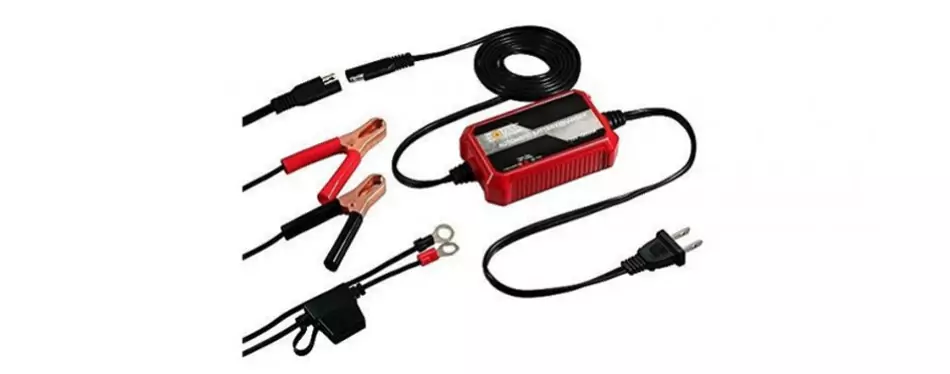
Some argue that this is the old method to charge the battery and is no longer considered good, but we did not find any substantial argument against it, so we decided to include it in our list still.
A trickle charger is also referred to as a maintaining charger; here is an example of a good one. This method helps make sure that your battery does not die during jet ski storage over winter. It is also a good option if you are looking into not overcharging your battery. Consider it as the least tricky alternative among others discussed. As a rule of thumb, overnight will charge the battery if it is fully dead. If it is half dead, then 4 hours is a good starting point for charging.
Smart Charging
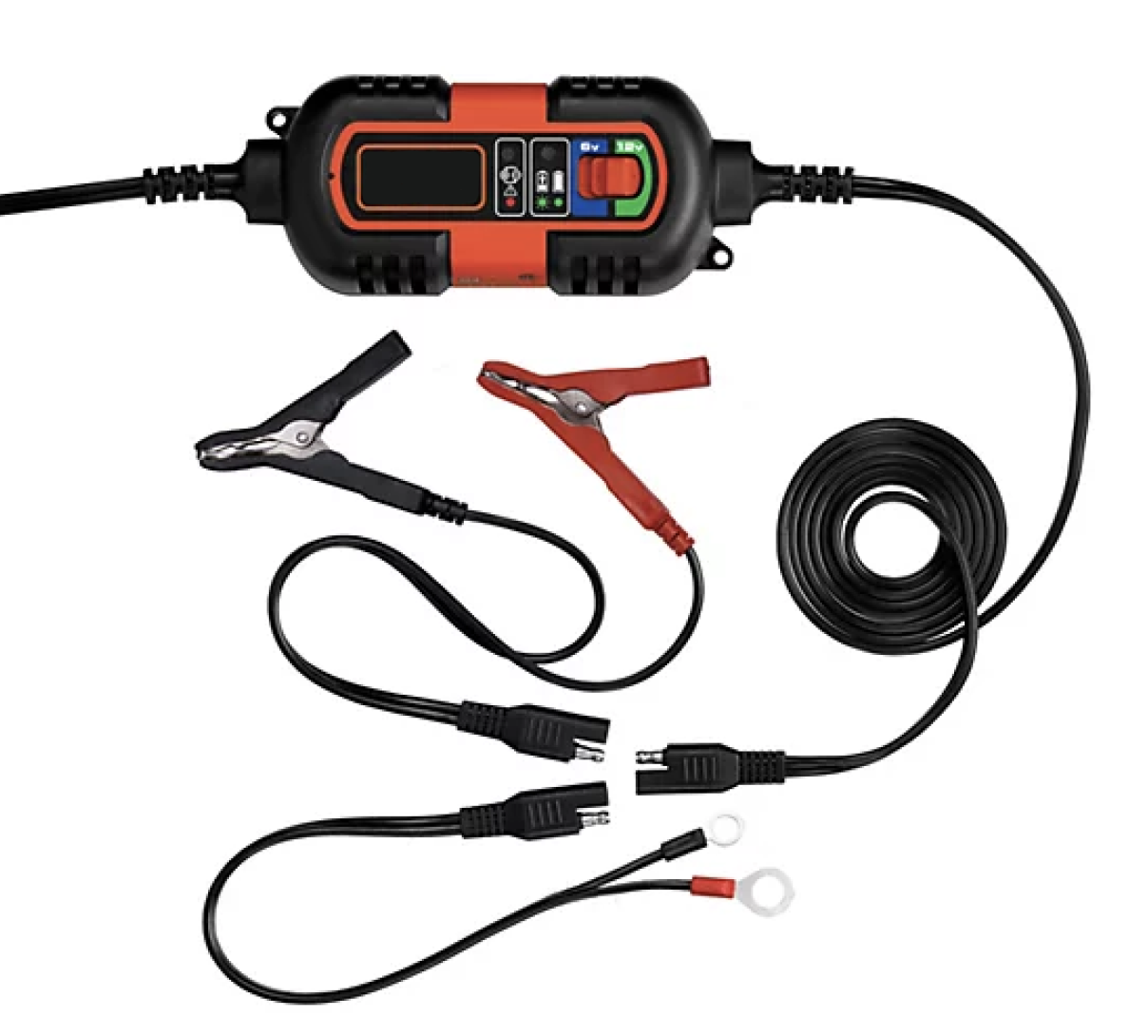
While trickle charging is a good option for storing the battery, smart charging is great for any time your jet ski is not on the water.
Smart Chargers like BLACK+DECKER require minimal user effort. You just plug it in and let it set. What is great about Smart Chargers is that you can leave them to any battery for any time duration, regardless of the battery type you are using it on. Just like with trickle charging, you take no risk of over or undercharging the battery, ergo it’s a “Smart” charger.
Solar Charging
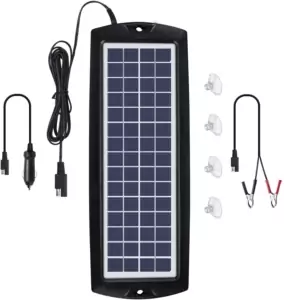
Are you looking for eco-friendly solutions? Then you should consider solar charging!
If you are looking for a cheaper option for chargers, Solar Chargers are a great option. If you offer jet ski camping tours or rent your equipment for several days to vacationers, this is an excellent alternative. The main advantage of Solar Chargers is that they do not need electricity, it comes solely generated from the sun. Consider this solar charger brand.
This can also turn into a great sales opportunity for your rental business. This is because customers these days are willing to pay more to businesses when they know that causes are supported. Additionally, consider embedding the solar panel into your jet ski; this is a very opportunistic solution to the issue.
Can Car charger be used for charging?
Yes, you can as long as it can go as low as 1-2 amp hours charging rate, which is not usually the case for car chargers. Many car chargers do not offer amperage this low; hence you can’t use them to charge a jet ski battery. A PWC battery should never be charged at a rate faster than 2 amps/hour because you do not want to fry it.
What if you need to charge multiple batteries at once?
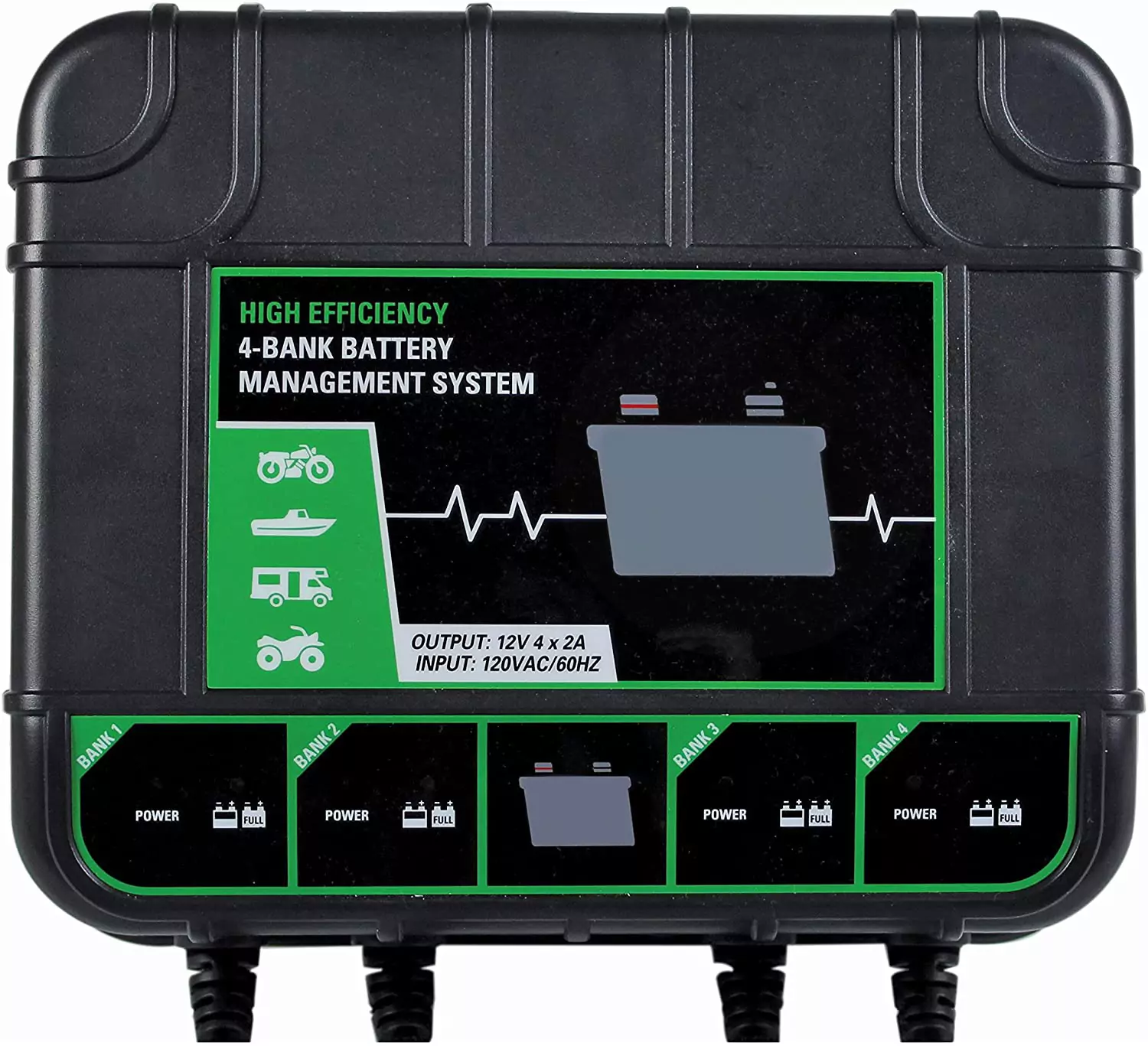
As a tour operator, it is quite likely that you would store multiple jet skis all at once; hence, chances are, you will need to charge multiple batteries at once.
A charger like Extreme Max Battery Buddy lets you charge up to 4 jet skis simultaneously. Voltage flow is safely regulated, so there is no risk of overcharging the batteries. Additionally, this charger provides a 12v and 2amp charge per bank. It also has an LCD screen, which indicates the charge level of each battery connected, and protection against short circuits and wrong connections.
How to make sure the battery is not overcharged
Your best bet would be to go either for trickle charging or smart charging. Otherwise, if you choose to go with other ways to charge your battery, like solar charging, then you may want to check things manually. As a rule of thumb, make sure you remove the battery from the jet ski and charge it with a small battery. Usually, 1 amp chargers would suffice to charge the battery at a slower speed.
Proper Battery Winter/General Storage
Finally, you may know that if you do not use a battery for an extended time, then you need to store it if you do not want to get a new one in the season. The question is, though, how to make it properly and hassle-free so that you can focus on inventory-management during the offseason. Read the following great tips to ensure you don’t have to allocate a budget for getting a new battery.
- Remove a battery from a jet ski just like you would do for charging it by undoing the bolts. Again, If you are not sure where your battery is located, refer to this blog section.
- Flip back the rubber cap from the battery’s negative terminal. To do this, utilize a Philips screwdriver for unfastening the screws connecting the battery cable to the negative terminal. Free the battery from the cable.
- Repeat the previous step, but for the positive terminal, and not the way around if you do not want to ruin the battery.
- Leave the battery in a dry place like a garage on top of a rubber mat. You can read more details on storage place conditions down below. Attach the battery to one of the chargers we suggested above and make sure everything is working.
- Check back every now and then when you get a chance at least once per month. The battery fluid level should not fall below the battery’s lower-level mark. If that happens, unscrew the battery cap with a flathead screwdriver and refill it with distilled water. Replace the battery cap afterward.
What is the best place for storing your battery?
The storage place should be free from winter weather. It is very crucial that you do not let your battery freeze; otherwise, you will have to get a new one.
We do not encourage keeping the jet ski battery at home either, because it can give off dangerous fumes. Keep the sparks away from the battery to avoid initiating a fire. Also, make sure that your storage place is free from kids.
Can you store a better on concrete?
Absolutely not, this will drain the battery! Don’t touch any fluids with your skin should that drain because it can be dangerous.
For how long can a jet ski battery last?
Jet ski batteries can last up to 5 years; however, if you take perfect care of your battery it can last even longer. If you follow all the maintenance tips suggested in our guide, that should do the trick. The bottom line is if you spend more time on maintaining your high-quality battery, you spend less of your money on getting new cheap ones every season.
Check Your Equipment Manual and Other Sources for Extra Tips
In conclusion, as always, we encourage you not to stop your research here. Start with your PWC’s manual to see if the manufacturer gives any suggestions on looking after it, which could connect with battery lifespan. For example, Yamaha WaveRunner’s website has an online tool that can pull up your model manual to advise on how to replace the parts. Also, many good sources on the internet will point you in the right direction on doing things the way they need to be, according to the battery model.
Your jet skis are committed to serving you throughout the seasons to make your customers happy, so why not return the favor to them by checking out their conditions occasionally? That will not only save you money on purchasing a new battery at the beginning of the new season but also your time on figuring out what might be wrong with it!



